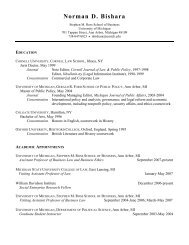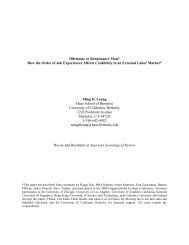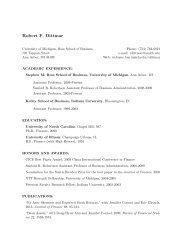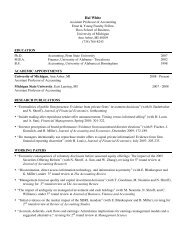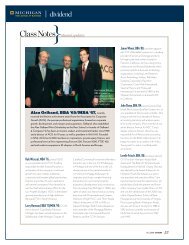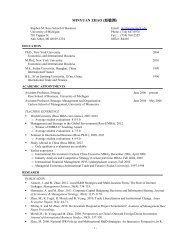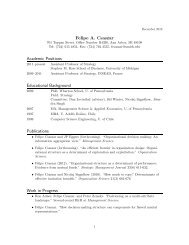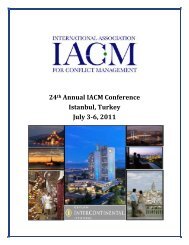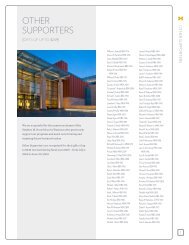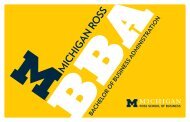DIvIDEnD - Stephen M. Ross School of Business - University of ...
DIvIDEnD - Stephen M. Ross School of Business - University of ...
DIvIDEnD - Stephen M. Ross School of Business - University of ...
You also want an ePaper? Increase the reach of your titles
YUMPU automatically turns print PDFs into web optimized ePapers that Google loves.
a legitimate concern. another concern: how is the firm going<br />
to measure a footprint? currently there is no universal<br />
standard on measuring scope 3 emissions. if it’s left to the<br />
suppliers, company one might use Protocol a, company<br />
two might use Protocol B, so what is the comparison?<br />
finally, some buyers are asking suppliers to report their<br />
footprint at a component or product level, an onerous task<br />
for a supplier to estimate.<br />
But having said that, the forward-looking suppliers already<br />
are doing what they can to reduce their environmental footprint.<br />
the issue that comes up is reporting that to the buyer,<br />
and at what level.<br />
DIvIDEND: Would one solution be to get the industry<br />
groups or trade associations to set standards, as long<br />
as there’s no collusion under the law?<br />
ANUPINDI: it has to come from that level. otherwise<br />
it’s not going to move. getting consensus is not going to<br />
be easy.<br />
DIvIDEND: What companies have been leaders in<br />
promoting a green supply chain, and what can we learn<br />
from them?<br />
ANUPINDI: Rei, starbucks, hP, cisco, walmart, and Dow<br />
are some names that come to mind. there are many others<br />
— large and small. in terms <strong>of</strong> lessons learned so far: first,<br />
there has to be a clear internal alignment between economic<br />
and sustainability concerns; this has to come from the top.<br />
sustainability should not be the sole responsibility <strong>of</strong> a<br />
sustainability group. sustainability thinking should permeate<br />
the entire organization. we learned from the quality movement<br />
that quality is not solely the responsibility <strong>of</strong> the<br />
quality control group; it is every employee’s responsibility.<br />
second, since sustainability is impacted by the entire supply<br />
chain, firms across the supply chain need to develop better<br />
coordination mechanisms and move away from arm’s-length<br />
to longer-term relationships. third, firms need to develop<br />
the capability to work with different types <strong>of</strong> organizations,<br />
including nonpr<strong>of</strong>its, environmental action groups, academia,<br />
etc. finally, sustainability could be a source <strong>of</strong> innovation —<br />
in both process and product — and hence a source <strong>of</strong><br />
competitive advantage.<br />
DIvIDEND: What kinds <strong>of</strong> issues are being researched<br />
in the field along those lines?<br />
ANUPINDI: within the supply chain field this is new and<br />
old. there has been a lot <strong>of</strong> work in the last decade on the<br />
reuse and recycle process. how does a firm structure this?<br />
how does it even think about collecting the products from<br />
the consumer and recycling? what is the best way to collect<br />
and move them through the system? what is the reuse<br />
potential? now companies have to think about product<br />
returns: Does it affect how they design their forward<br />
distribution to get products to consumers? that is one area<br />
<strong>of</strong> research: the shift toward recyclable conveyances to move<br />
a product across the supply chain, e.g., moving products in<br />
cardboard boxes versus moving them in recyclable plastic<br />
containers. consider watermelons, which move in these big,<br />
cardboard containers. the box is bought by the farmer. it is<br />
sent to the retailer, and it is up to the retailer to dispose <strong>of</strong><br />
that cardboard. But if the company uses a recycled plastic<br />
container, the container has to go back to the beginning <strong>of</strong><br />
the supply chain from the retailer. what was an open-loop<br />
supply chain has become a closed-loop supply chain. instead<br />
<strong>of</strong> the product being recycled, an asset is recycled. that<br />
opens up new questions: who<br />
owns the asset? how should the<br />
asset be deployed? is it ownership<br />
transfer or is it a lease<br />
model? if so, who’s going to lease<br />
it? who owns it — the manufacturer,<br />
the retailer, or the farmer?<br />
how many assets need to be<br />
deployed, and who’s going to<br />
track them? who is responsible<br />
if the asset gets damaged? these<br />
are issues people never thought<br />
about. there are solutions and<br />
models out there, but it’s a big<br />
challenge to get everyone on<br />
board to agree to a solution.<br />
measuring an environmental<br />
footprint accurately is a big<br />
issue. it is relatively easier to<br />
> sustainability can be a<br />
source <strong>of</strong> innovation and<br />
competitive advantage, says<br />
pr<strong>of</strong>essor ravi Anupindi.<br />
measure a footprint at a firm/facility level. But most buyers<br />
are requesting that footprint information be provided at<br />
a components or product level. estimating this is not a<br />
trivial task. it has parallels in accounting. in accounting the<br />
challenge is, “i have this big overhead cost. how do i allocate<br />
it?” maybe there are different allocation systems that have<br />
better or worse efficiencies. we can follow a similar approach;<br />
however, this is an open area <strong>of</strong> research.<br />
then there is the issue <strong>of</strong> how regulation impacts operations.<br />
Product take-back regulations have been passed in europe.<br />
how does it affect the design <strong>of</strong> the product? if there is<br />
product reuse or remanufacturing, there are going to be<br />
two versions <strong>of</strong> a product, new and remanufactured. how<br />
does a company price these? how much capacity should<br />
be allocated between those two? all those issues are coming<br />
to the forefront <strong>of</strong> research. —Terry Kosdrosky<br />
spring 2010 <strong>DIvIDEnD</strong> 23



